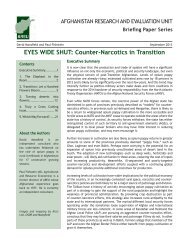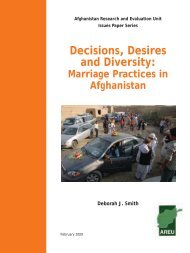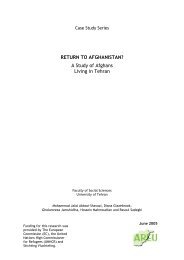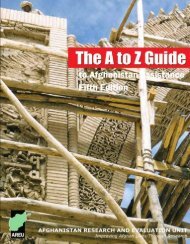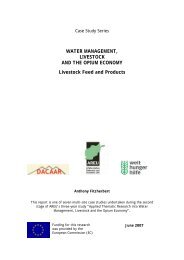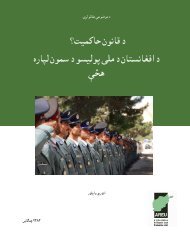Local Governance in Afghanistan: A View from the Ground
Local Governance in Afghanistan: A View from the Ground
Local Governance in Afghanistan: A View from the Ground
- No tags were found...
You also want an ePaper? Increase the reach of your titles
YUMPU automatically turns print PDFs into web optimized ePapers that Google loves.
<strong>Afghanistan</strong> Research and Evaluation Unit<br />
2011<br />
The United States is by far <strong>the</strong> largest actor. It had various levels of fund<strong>in</strong>g authority, but projects<br />
up to $25,000 could be signed off by <strong>the</strong> PRT commander. The United States <strong>in</strong>tegrates staff <strong>from</strong><br />
<strong>the</strong> State Department and USAID as well as military and civilian specialists on law, health, education,<br />
agriculture and <strong>in</strong>frastructure. O<strong>the</strong>r PRTs similarly <strong>in</strong>tegrate civilian specialists <strong>in</strong>to <strong>the</strong>ir activities.<br />
In particular, <strong>the</strong> work undertaken by <strong>the</strong> American PRT <strong>in</strong> Laghman s<strong>in</strong>ce its establishment <strong>in</strong> 2005 has<br />
been remarkable. A prov<strong>in</strong>ce with no paved roads o<strong>the</strong>r than <strong>the</strong> Kabul-Jalalabad Highway is now well<br />
served with good arterial networks, along with an <strong>in</strong>creas<strong>in</strong>g array of hospitals, schools, and local<br />
government build<strong>in</strong>gs. In 2010 <strong>the</strong> PRT was deliver<strong>in</strong>g on projects to <strong>the</strong> value $40 million, though<br />
as its commander stated, “fund<strong>in</strong>g limitations were more political than developmental.” Although<br />
<strong>the</strong> situation <strong>in</strong> Laghman is quieter than <strong>the</strong> more volatile sou<strong>the</strong>rn prov<strong>in</strong>ces such as Helmand, <strong>the</strong><br />
PRT is still work<strong>in</strong>g <strong>in</strong> an environment where elements oppos<strong>in</strong>g <strong>the</strong> government ma<strong>in</strong>ta<strong>in</strong> substantial<br />
control of <strong>the</strong> prov<strong>in</strong>ce.<br />
5.8 Conclud<strong>in</strong>g remarks<br />
When look<strong>in</strong>g at government service delivery, <strong>the</strong> dependence on donor fund<strong>in</strong>g is strik<strong>in</strong>g, no matter<br />
what <strong>the</strong> sector. Without <strong>the</strong> present level of resource flows, very few of <strong>the</strong> efforts described<br />
above would be able to take place. The consequence of a military withdrawal <strong>in</strong> 2014, should it<br />
happen, will have a substantial impact on resource availability, particularly with <strong>the</strong> end of PRT<br />
and CERP funds which alone amount to about 20 percent of an $8 billion development budget. 71<br />
In addition, <strong>the</strong> economy will be deprived of <strong>the</strong> contracts associated with servic<strong>in</strong>g <strong>the</strong> military<br />
presence, amount<strong>in</strong>g to $14 billion annually for <strong>the</strong> United States alone (see Footnote 2). While <strong>the</strong><br />
police and <strong>the</strong> army will no doubt reta<strong>in</strong> <strong>the</strong>ir fund<strong>in</strong>g, debates need to take place now as to how<br />
<strong>the</strong> Afghan government can susta<strong>in</strong>ably support health, education and rural development. Apart <strong>from</strong><br />
render<strong>in</strong>g many exist<strong>in</strong>g development <strong>in</strong>itiatives unsusta<strong>in</strong>able, a reduction <strong>in</strong> aid flows will also have<br />
a significant effect on l<strong>in</strong>e m<strong>in</strong>istry operational budgets (currently utilisation rate is 92 percent 72 ).<br />
Many m<strong>in</strong>istries have <strong>in</strong>creased <strong>the</strong>ir staff <strong>in</strong> recent years, but if operational budgets are reduced,<br />
<strong>the</strong>re will be a need to downsize. However, if this is too politically sensitive, <strong>the</strong>n development<br />
budgets will be fur<strong>the</strong>r affected.<br />
Core/Periphery dynamics: A consistent dynamic observed <strong>in</strong> all six study prov<strong>in</strong>ces was that quality<br />
of service delivery was <strong>in</strong>versely related to remoteness and levels of lawlessness. This dynamic was<br />
at work not just between prov<strong>in</strong>ces and <strong>the</strong> centre, but also with<strong>in</strong> <strong>the</strong>m. 73 Peripheral prov<strong>in</strong>ces such<br />
as Day Kundi and Sar-i-Pul were poorly served <strong>in</strong> respect of adm<strong>in</strong>istrative services, health, education<br />
and <strong>in</strong>frastructure. Across all study prov<strong>in</strong>ces, service delivery <strong>in</strong> districts closer to <strong>the</strong> prov<strong>in</strong>cial<br />
centre was noticeably better than <strong>in</strong> ones far <strong>from</strong> it. Even with<strong>in</strong> relatively affluent prov<strong>in</strong>ces, <strong>the</strong>re<br />
were districts that were very poorly served, such as Roye Doab and Dara-i-Suf Bala (Samangan),<br />
Qarq<strong>in</strong> and Khamyab (Jawzjan), and Dawlat Shah (Laghman). In Balkhab (Sar-i-Pul), l<strong>in</strong>e departments<br />
also had to deal with pressure <strong>from</strong> commanders and political parties. This highlights <strong>the</strong> need for<br />
greater attention to be paid to peripheries and suggests that <strong>the</strong> system as it currently stands is<br />
overly network orientated. This is especially important given <strong>the</strong> fact that, accord<strong>in</strong>g to this study’s<br />
evidence, poverty and lawlessness are closely l<strong>in</strong>ked <strong>in</strong> peripheral areas.<br />
M<strong>in</strong>istry Coord<strong>in</strong>ation: Lack of coord<strong>in</strong>ation between l<strong>in</strong>e departments both with<strong>in</strong> and between<br />
prov<strong>in</strong>ces is ano<strong>the</strong>r area of concern. In some prov<strong>in</strong>ces, MRRD employees reported that <strong>the</strong>y had<br />
received little support <strong>from</strong> <strong>the</strong> M<strong>in</strong>istry of Public Works (MoPW) <strong>in</strong> <strong>the</strong> construction of roads. This<br />
lack of collaboration between prov<strong>in</strong>cial l<strong>in</strong>e m<strong>in</strong>istries is consistent with <strong>the</strong> “silo” phenomenon<br />
described by <strong>the</strong> World Bank, where each m<strong>in</strong>istry functions as a self-conta<strong>in</strong>ed unit. 74 Coord<strong>in</strong>ation<br />
71 When considered <strong>in</strong> addition to traditional overseas development assistance. For more <strong>in</strong>formation on <strong>the</strong> national<br />
development budget composition, see <strong>the</strong> A to Z Guide to <strong>Afghanistan</strong> Assistance, N<strong>in</strong>th Edition (Kabul: AREU, 2011), 50.<br />
72 M<strong>in</strong>istry of F<strong>in</strong>ance, “<strong>Afghanistan</strong>’s National Budget for 1384-88.”<br />
73 For a discussion on this see: Antonio Giustozzi and Dom<strong>in</strong>ic Ors<strong>in</strong>i, “Centre-Periphery Relations <strong>in</strong> <strong>Afghanistan</strong>: Badakhshan<br />
between Patrimonialism and Institution Build<strong>in</strong>g,” Central Asian Survey, 28, no 1 (2009), 1-16.<br />
74 The World Bank described m<strong>in</strong>istries <strong>in</strong> <strong>Afghanistan</strong> as vertically-conf<strong>in</strong>ed structures that lack horizontal <strong>in</strong>tegration. See:<br />
“Service Delivery and <strong>Governance</strong> at <strong>the</strong> Sub-National Level <strong>in</strong> <strong>Afghanistan</strong>” (Wash<strong>in</strong>gton, DC: The World Bank, 2007).<br />
<strong>Local</strong> <strong>Governance</strong> <strong>in</strong> <strong>Afghanistan</strong>: A <strong>View</strong> <strong>from</strong> <strong>the</strong> <strong>Ground</strong><br />
38



